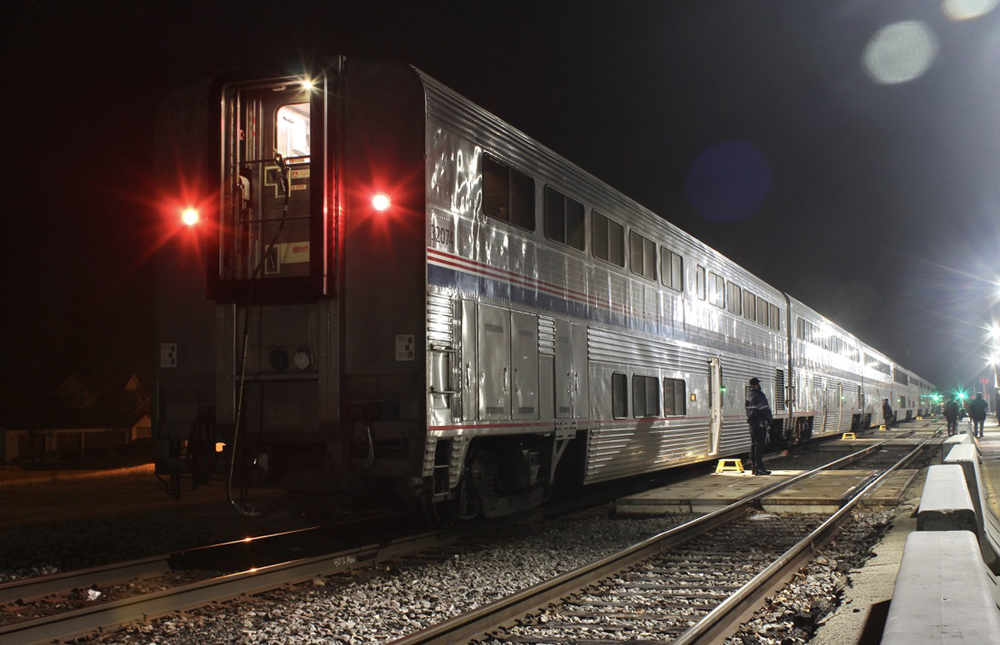
WASHINGTON — Equal accessibility to onboard amenities for passengers with disabilities is the goal of potential new long-distance railcar designs Amtrak unveiled Wednesday at an in-person and online hearing.
Amtrak held the gathering to obtain feedback prior to procurement from the accessibility community regarding plans to replace its existing Superliner and single-level fleet with new rolling stock. The 1970s bilevel designs and 1980s Viewliner prototypes were developed before establishment of c regulations under the Americans with Disabilities Act of 1990.
“Since April, we’ve been listening to stakeholders to understand where the pain points are on the current fleet and also understand what the aspiration is for the future,” Amtrak President Roger Harris noted in opening remarks. “We’ve assembled those visions in a concept … to make a product that’s better than strict compliance to ADA regulations,” a process defined as equivalent participation. He added, “With bilevel equipment, we want to make sure there is full accessibility to the upper level, so people can enjoy all of the amenities up there in terms of dining and sightseeing in both coach and sleeper service.”
Fixed consists a key feature
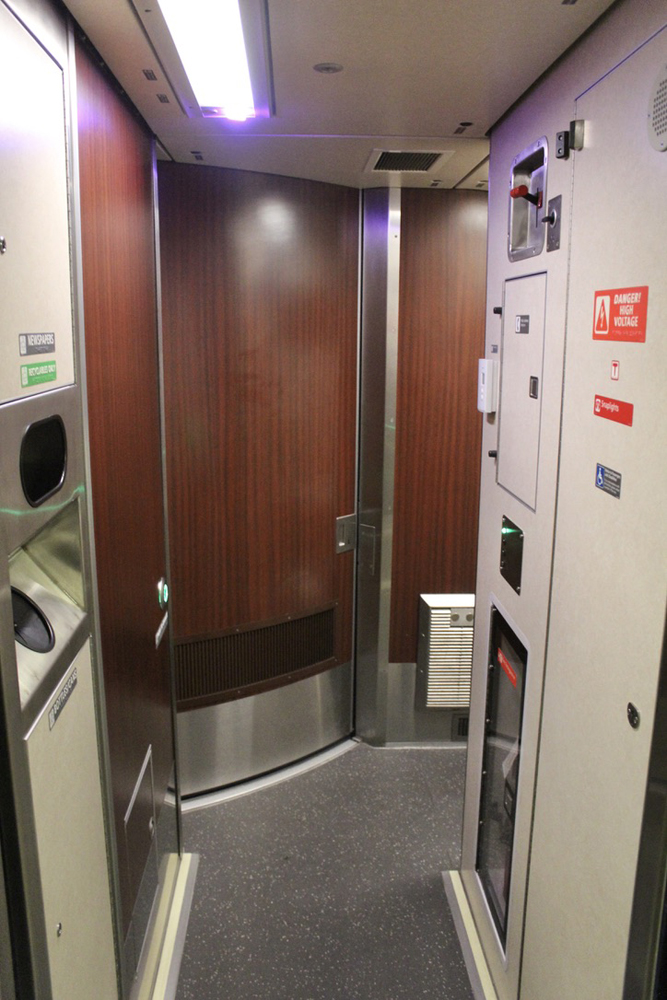
To ensure both single-level and bilevel equipment has a 32-inch-wide accessible path throughout, Fred Gazzolo, Amtrak vice president of product development and analytics, explained cars would need to be semi-permanently coupled. Compliance with current ADA regulations, which address accessibility on a car-by-car basis, would still mean travelers with disabilities would be sequestered in isolated spaces, as is currently the case.
Two “alternative design” concepts, one for a 10-car, single-level trainset and the other for a nine-car bilevel set, encompass the following standards:
— Accessible coach and sleeper space equal to or greater than the non-accessible space
— Dining and lounge facilities are located in a central “accessible core;” a trainset’s accessible coach seats and sleeper space are located nearest these amenities in “priority positions.” The core runs through cars 2 through 7 on the single-level set and 1 through 6 in the bilevel design.
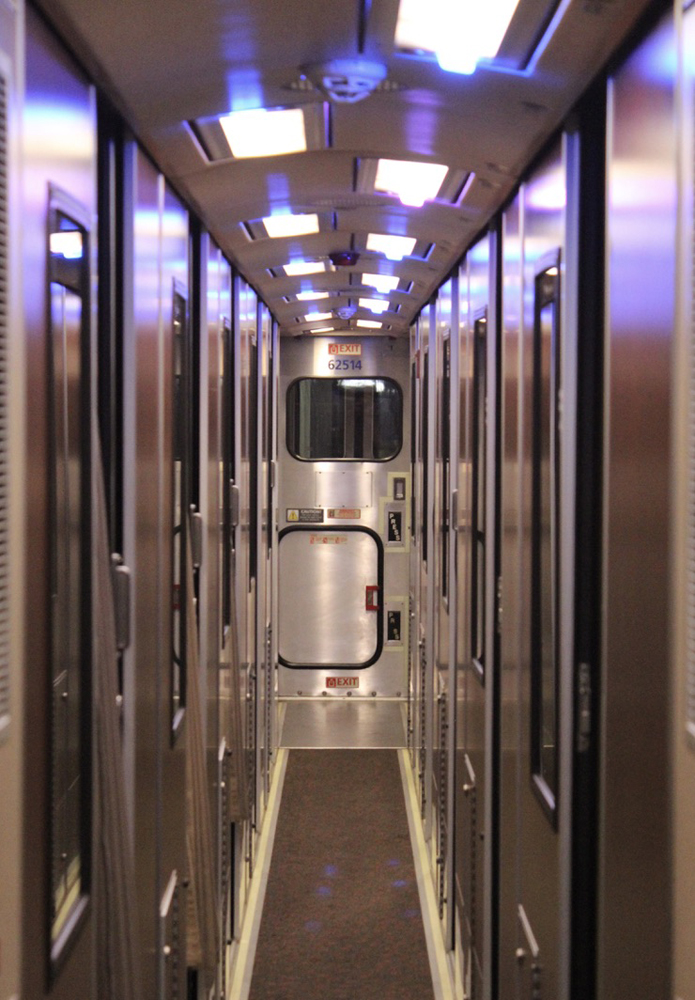
— Each passenger will have access to more than one accessible restroom on both trainset types, and elevators on bilevel trainsets (located in cars 2 and 6) for boarding and deboarding.
The following preliminary concept designs were presented. Only some seats in accessible coaches, cafés, dining, and lounge cars are accessible, but they all have access to the 32-inch-wide accessible core and bathrooms with a 60-inch turning radius. Sleeping accommodations and configurations were not specified; details mentioned are News Wire estimates based on diagrams shown during the hearing:
The 10-car single-level trainset proposal (shown in the diagram below) includes:
- Non-accessible coach, 2-2 seating.
- Half non-accessible/half accessible coach, 2-2 seating; 32-inch path begins.
- Non-accessible 1-2 seating/accessible coach.
- Accessible coach (1-2 seating)/café
- Accessible diner/galley
- Accessible diner/lounge (diner section adjacent to galley in car 5)
- Sleeping car, 3 accessible bedrooms, 2 non-accessible bedrooms; 32-inch path ends.
- Non-accessible roomette sleeper
- Non-accessible bedroom sleeper
- Utility car (crew-baggage).
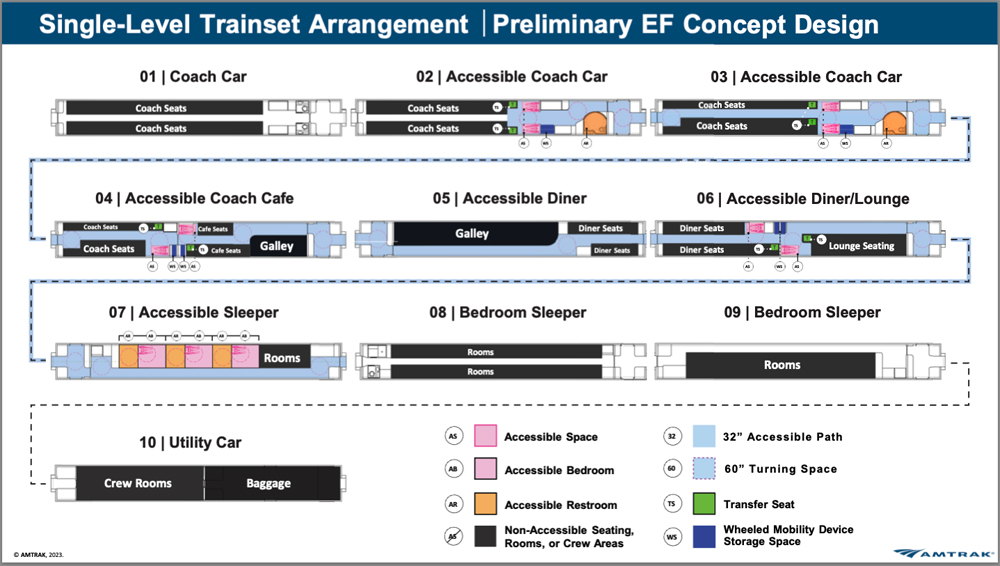
The 9-car bilevel trainset: non-accessible features on lower level listed first; top level accessible, as shown in the diagram below (in the diagram, the upper level is on top).
- Lower: Non-accessible coach 2-2 seating
Upper: Accessible seating, bathroom; 32-inch path begins.
- (Elevator) Lower: Non-accessible 1-2 seating
Upper: Accessible coach/bathroom.
- Lower: Non-accessible coach.
Upper: Accessible coach/café (1-2 coach seating—café at one end of the car)
- Dining car with some accessible seating (galley below)
- Lower: Sleeper, roomettes and family room.
Upper: Accessible lounge (no exteriors shown)
- (Elevator) Sleeper, lower: Roomettes and family room.
Upper: Non-accessible (2 bedrooms); accessible (3 bedrooms); 32-inch path ends.
- Lower: Sleeper, roomettes and family room
Upper: Non-accessible bedrooms.
- Lower and upper, non-accessible roomettes.
- Utility car, Lower: Baggage
Upper: Roomettes/crew rooms
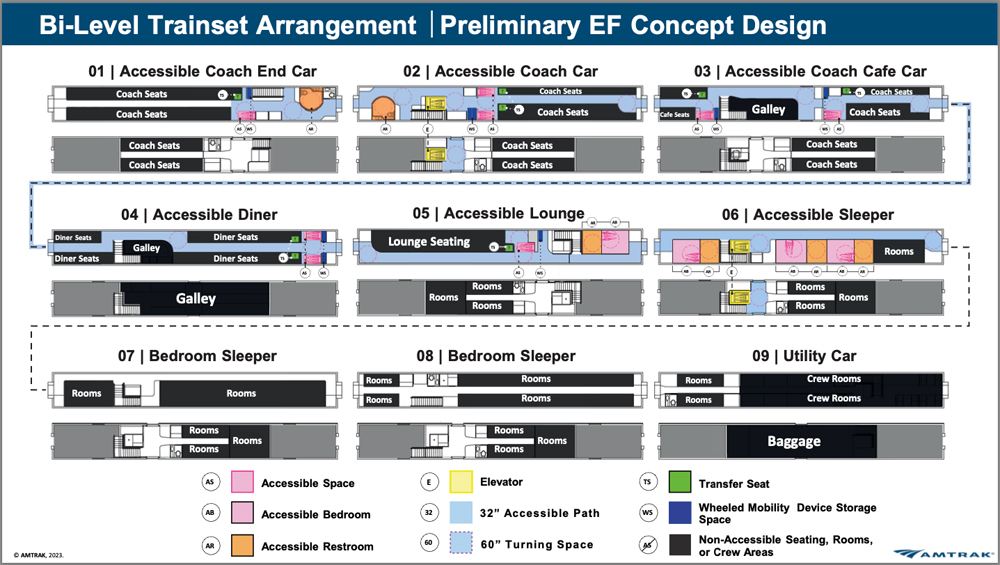
These proposals are only the starting point to elicit comments from the traveling public before any extended procurement process begins. Production of multiple car types is not new; both Pullman and Budd responded to customized railroad requests in the post-World War II streamliner conversion boom. But the process incurred substantial challenges with CAF-USA in the four car types involved in the 125-car order for Viewliner II sleeping, dining, and baggage cars that took more than 10 years to deliver.
The suitability of fixed-consist trainsets will also be debated, since demand varies widely among the routes Amtrak operates today. Combining coach seating with somewhat reduced lounge and dining car amenities may also be a concern.
Following the presentation, two commenters expressed the need for built-in lifts, such as those available on California Car and Pacific Surfliner coaches, rather than reliance on platform-based devices that are difficult to deploy.
Comments are being accepted through Sept. 5, 2023, at this Amtrak website.
— Updated Aug. 31 at 6:10 p.m. with Amtrak diagrams of trainset concepts.














We really need a birdseye view of the car designs to determine how everything fits together. I’m pretty concerned about the lack of lounge and entertainment space, as nobody wants to be cooped up in their seats or rooms all day. I’m afraid that not accommodating this need would result in lower ridership. For that matter, any single-level cars should include some sort of standalone lounge. The current cafe setups in the Viewliners are largely insufficient for riding LD.
Whatever long-distance equipment Amtrak opts for, it must be comfortable. Most passengers will spend more time on it than shown in the schedules.
In 2022, long-distance riders were late by an average of 108 minutes. The California Zephyr turned in the worst performance with 161 minutes, followed closely by the Sunset Limited at 158 minutes. The best of the tardy trains was the Palmetto at 58 minutes.
Today, September 4th, the Texas Eagle is running slightly more than 3 hours late into Temple. The good news, however, thanks to schedule padding, assuming no further delays, it should get to San Antonio at 11:32 PM, which is just 1 hour 37 minutes late. Plenty of time to get to the gin joints before they close!
That “cor may work adequately for the SWC or CZ; not very well for either the Empire Builder or theSunset/Texas Eagle. Certainly will not facilitate the long needed Capitol Limitedto/from Pennsylvanian transfers either. All of the consist “freezing” Amtrak tried (SWC sharing w/Capitol, and others) made tailoring consists to actual market conditions harder. Linked sets work fine for subways where the fleet is sufficient to take 5 cars OOS when only 1 is actually defective. Doing thesame for LDTs would actually require a much larger spares fleet.
First, nominally fixed consists were tried both for LDTs (original Zephyr, City of Salinas, 1st COLA) and long commutes (PRR Keystone). They all failed to work out because travel fluctuates. (Acelas fill out with fire sale discounts)
Second, the drawings presented show inadequate lounge space for real LDTs. Ride any of today’s LDT that have full length lounge/sightseer cars–they are full all dayand most of the evening.
Third, much as my 79 yr old knees don’t like ascending stairs and I have a goddaughter in a whlchair, depending on Amtrak to actually field functioning elevators is a cruel joke. I loved dome cars, and if I thought Amtrak could be trusted to put a dome car in a train with afunctional elevator, that would be great.
I believe Amtrak shouls return to single level equipment, build enough of each configuration to fill out existing and additional LDTs with full dining available to all pax, and lounge, sighseeing space the same. The 4″ mistake causing the Acelas to be too narrow, needs to be fixed between NH and BOS and while we are at it, ALL of the platforms need to become high level so that all trains can be run system wide. Yes, that means some changes for the California Corridor trains, or a periodof two level platforms at some stations, but the convenience of roll on/roll off both for humans andluggage will decrease dwell.
In short, Amtrak,time for a different set of crayons.
More sleeping car capacity and reduced lounge space doesn’t seem like a feasible solution. A dedicated lounge car would be nice. But maybe a dedicated cafe car could mean more seating availability. However, the biggest question is why Amtrak would opt for trainsets rather than individual railcars? Long distance routes experience more extensive demand kinks than state supported routes and the Northeast Regional. As a result consists are frequently adjusted. The Southwest Chief is a good example. In historic years before Covid, its consist ranged from one sleeping car, a transition sleeper car, and two coaches from January to April to three sleeping cars, a transition car and three coaches from Chicago to LA with a fourth coach between Chicago and Kansas City during Christmas and New Year travel rush.
As submitted to the Amtrak site:
1. This proposal to consolidate the accessible accommodations close to the food service and lounge areas of the train makes sense.
2. However, this proposal would be better served to consider some modifications to the type and number of accessible accommodations instead of just trying to match the older standard based on the number of accommodations per railcar. Of note, nothing seems to being proposed for those with travel-limiting disabilities that do not require a wheelchair to make the sleeping accommodations more accessible for those individuals. From BTS data at https://www.bts.gov/travel-patterns-with-disabilities it would seem about 6.7% of Americans who would be traveling outside the home have travel-limiting disabilities but less 20% of the 6.7% use some type of wheeled medical aid at some time, or 1.4% of Americans.
It would seem logical to set a standard based on the total train passenger capacity per type of service (coach or sleeper) rounded up to the nearest integer as long as a larger percentage of sleeper rooms were designed for the 5.3% of Americans with travel-limiting disabilities that do not require a wheelchair but preclude one from climbing to an upper bed(berth) within the room unaided. These rooms should have a bed sized for two people (as this conditions corelates to age, likely leading to paired impacted couples) at roughly seat cushion level with perhaps an optional berth above so the room could be sold to young families too, who have their own limiting conditions when traveling with infants and toddlers.
This concept of dividing out the levels of accessibility is essentially what is done in the automobile parking regulations where there are Van accessible places and what are essentially walker accessible places. So the proposal should consider consolidation of the accessible places but providing 1.4% of spaces for wheelchair users as close as possible to observation lounges and food and beverage service if not within the same car and 5.3% of spaces for limited-mobility walker and cane users in a new design room for the sleeping car class that does not require an upper berth be used to accommodate two people.
3. For both the single level or bi-level concept some type of inter-car lateral roll damper and continuous gangway floors needs to be considered for there to reasonably be a wheelchair path between cars as around 1 inch of dynamic misalignment occurs with existing equipment with the most pronounced effects seen on the bilevel equipment due to the height of the pathway above the top of rail. Perhaps for this reason it might not be reasonable to plan for an inter-car pathway for the bilevel fleet until some type of study is done. As noted next, there are some better alternatives for the bilevel fleet than presented in the sketches that would allow for wheelchair users to remain as much as possible within a single car.
4. The bilevel design would seem better served for the observation/lounge car to host (2) large accessible rooms on the lower level, (2) elevators as noted, and then move the café kiosk to the upper level where a fully accessible open floorplan could be provided along the entire car. From the sketches it seems each accessible room for wheelchair passengers is about 13 feet long, so (2) of these type sleeping accommodations, entrance vestibule, stairs, elevators, and luggage storage will use up almost all of the lower level.
The only drawback is the sleeping room itself would not be on the best level for viewing but the vastly simpler and safer accessible to fully accessible top observation level by elevator would seem to create a space far exceeding the intentions of full access when considering the difficultly in traversing between bilevel cars noted before. This would also allow for this type car to be paired with a dining car for accessible travel if one so desired between cars or simply for the dining car waiters to provide table service in the lounge/observation car for wheelchair passengers.
Percentwise, existing bilevel consists with one lounge will only need around 0.9 wheelchair accessible rooms and (2) would be provided. But if a larger consists is needed (4) rooms would be had for the train, (2) in each lounge as another lounge is added perhaps in the coach section. The other new design sleeping cars could include many more bedrooms accessible to people with mobility-limiting cane and walker users thus improving the overall access to the entirety of the population.
5. The single level design sketch showing there to be a 32” accessible path past the dining car galley would serve no real mobility purpose as essentially the same lounge type services are offered in the sketches on either side of the galley. However, a wider path would restrict the overall width of the galley such that the workers within would be impacted, particularly those who are larger in stature, by the loss of 6” of space in an already small working area next to hot appliances on a moving train. For the single level proposal it might make sense to include (1) accessible room in the lounge/observation car on the opposite end of the car separated from the seating by a narrow serving galley with a greater than 32” clear path past the serving counter.
As in the bilevel comments this would allow for access to all of the observation options offered on the train without the hazards of trying to navigate between cars. Percentwise, existing single level consists with one lounge will only need around (0.6) wheelchair accessible rooms, but if a larger consists is needed (2) rooms would be had for the train, (1) in each lounge as another lounge is added.
The key statistic is not the number of mobility impaired Americans that travel. It is the number that are likely to ride Amtrak. Also, it would include the number of mobility impaired overseas visitors.
I lived in Dallas for 33 years. In response to the Americans With Disabilities Act, the government spend millions putting in sidewalks and curbs that make it easier to navigate them in wheel chairs or step up to them with a walker. Near my north Dallas home they put in ADA compliant accesses even where there were no sidewalks. They have gone largely unused.
Amtrak needs to be realistic about the need to accommodate mobility impaired passengers. Otherwise, the taxpayers, who are Amtrak’s piggybank, will be on the hook for facilities that will be under used.
“Somewhat reduced lounge seating”? Looks like dramatically less lounge space. The lounge car’s appeal on long-distance trains for attracting passengers cannot be underestimated. Except in this ill-advised plan it would seem.
Around 8% of the population has a travel-limiting disability but only 1% of the population uses a wheelchair. I am curious as to why there isn’t any discussion of providing a greater number of sleeper rooms with a almost-queen sized beds at a regular level suitable for two people and perhaps only a smaller pull down berth above the feet area that could be used on occasion if the room was sold for young families.
It seems this study spent a lot of effort on 32″ corridors and elevators and not much effort on figuring out how to accommodate the much larger population of limited-mobility citizens for whom an upper berth just doesn’t work. I will put in a comment but you know how well that typically goes this late in the game.
https://www.bts.gov/travel-patterns-with-disabilities
Mr. Smith corridors not connected to a national network would fail unless gas prices skyrocketed & short distance flights were banned as was proposed in France.
Assuming every long-distance train rider in FY22 transferred to or from a corridor train, they would make up approximately 18% of the corridor passengers. But it is doubtful that every long-distance rider comes from or to a corridor train. The actual percentage is probably less than 5%.
In FY22 the NEC, the best U.S. example of a corridor, had Operating Earnings of $250 million. For the state corridors it was $9 million. The long-distance trains had Operating Losses of 347 million.
In FY22 Amtrak began reporting System Fixed Costs by route. After adjustments for these costs, the NEC had Operating Earnings of $1 million compared to a loss of $185 million for the state corridor trains and $563 million for the long-distance trains.
The numbers show there is no reason to believe that properly designed corridor services would need connecting passengers from the long-distance trains to make a go of it.
The greatest potential for many of the existing or proposed corridors is offering a service that gets people out of their cars.
Probably by time they implement any of these ideas or plans they still won’t be providing on time service.
Fixed-length trainsets are faster and more efficient with distributed power via axles on the individual cars. This works best of course with… electrification ! So, if these aren’t NEC, Amtrak is envisioning some serious electrification elsewhere.
If Amtrak were managed like a business, it would not be considering new cars for long-distance trains. Its focus would be on corridor trains. This is where passenger trains make economic sense. But Amtrak is a federal government creature. Getting rid of the long-distance trains is not politically doable.
Amtrak’s long-distance trains should be equipped with three types of low-level cars, i.e., coaches, lounges, and business class. They should be designed to accommodate mobility challenged passengers.
The coaches should have deep hollow, reclining seats. They should be wide enough to accommodate the expanded girths of most Americans. The lounge cars, which have a full-length dome where clearances permit, should offer an upgraded menu with the option to eat at a table or have the goodies delivered to the passenger’s seat. The business class cars should be equipped with pods like those found in business class on overseas flights.
Approximately 15 percent of Amtrak’s long-distance riders are in first class, and most of them are on the train just one night. I have flown round trip between LAX and Melbourne, Australia 15 times. On most of the trips I opted for business class. The pods were very satisfactory.
Simple systems work best. Applying this fundamental concept to Amtrak’s long-distance cars could help cut the losses on the long-distance trains, which in FY22 were $563 million.
The losses on long-distance services include stiff charges for corporate overhead for NEC infrastructure to support those “profitable” trains Profitable above-the-rail I believe, but factor in infrastructure costs and it is another matter.
The long-distance trains, when properly equipped and operated, do not lose that much money. Some are said to be profitable above-the-rail. They pay a minimal rental charge to use tracks provided by the private sector.
My question is how trains like the Lakeshore Limited with sections to/from BOS and NYC are going to work with semi-permanently coupled trains? Will the Lakeshore run in two separate sections from Chicago to BOS and NYC? Or will BOS passengers have to detrain the NYC train in Albany and reboard a different equipment set to BOS? Or will the NYC passengers have to detrain the BOS train somewhere between Buffalo and Albany and transfer to Empire Service trains to NYC?
Maybe the Boston and New York sections should each be a separate train.
To make my earlier post more grammatically correct, I meant to say that each section should operate through to Chicago as a separate train.
You could also ask the same question about the Empire Builder
Why do they even need bi-level cars? To me, Amtrak would get better economies of scale, reduced mechanical complexity (e.g., no elevators) and increased system-wide flexibility if they focused on a single-level design.
Good question Charles! Probably because they (airlines) don’t want to encourage the handicapped to fly, they see them as too much work & risk. The politicians look the other way because they & some of the flying public find it “uncomfortable” to encounter such adversity. I’m sure if they could they’d find a way to keep minorities off too, but I suppose ticket prices higher than bus & rail is the best they can do! As for this new LD equipment I agree the only way some of us will live to see this is if we die & get reincarnated!
Amtrak is violating a fleet planning principle contained in a prior fleet plans . . . specifically to focus upon acquiring off the shelf designs.
These cars reflect a new design which builders have never assembled. I will not live to see these cars enter service and there is no coherent plan to extend the life of existing equipment.
Maybe this will be a solution. Run a fixed consist train on most routes. If highly undersold make a marketing decision to offer seats heavily discounted maybe 48 hours before time at each departure station. If selling out attach individual cars to make the fixed consist much longer. Or if demand very high run an extra section.
but what’s wrong with long distance passenger trains using cars individually and why use fixed consist instead of individual passenger cars anyway ?
When will airlines be held to the same standards for disabled access? (Or any standards at all.)
On Monday’s flight DEN-MKE, two severely disabled (and overweight) passengers were loaded into coach class. I was in the front (first class) so I don’t know how they fared for two and a half hours, but I shudder to think of their comfort or for that matter their safety. I do know this: it’s six-across seating with no seats removed for their needs.
A couple of years ago, Amtrak was reamed over the coals for charging to remove seats for wheelchair transportation. Which airlines never do.
Sir, the ACAA (Air Carrier Access Act) prohibits discrimination. It apparently says nothing about either “Safety” or “Comfort”…
As a Federal stepchild of illegitimate parentage, Amtrak has a “special obligation” for handicapped access.
The Twin Zephyrs ran with fixed consists 1936-1947 and the fixed consists went to the Nebraska Zephyr until 1969. The Metroliners were fixed consists. Acela trains are fixed consists. Most Amtrak trains have fixed consists, meaning each trip has the same mix of cars, not necessarily the same cars.
Airline trips are operated with the same type of aircraft for the same schedulled flight each day. That’s a fixed consist.
An interesting note: if Amtrak used only trackage cleared for US Army Abrams tanks, cars could be 12 feet wide with plenty of ADA room.
The original Metroliners were NOT fixed consists. In fact, the first months they featured parlors and lounges as the straight coaches weren’t accepted yet (The GE powered cars met specs, WH, not) As EMUs, the Metrolinerscould have been5-8 cars long rather than 4.
Semi-coupled consists are NOT necessary to accomodate the requirements Amtrak wants…you can easily build individual cars with those requirements. It allows more flexibility in making up train consists depending on demand. Fixed consists hamstring Amtrak’s ability to grow volume and meet future demands.
These designs are actually very clever. There is a “core” of six accessible cars that allow passage of wheelchairs that include coaches, lounge, diner and sleeper.
Outside of that you can add non-accessible coaches in the front and non-accessible sleepers (one design being full roomettes and one being full bedrooms) to the rear of the core cars.
I have other issues with the designs, like the lounges which have seating on only one side, but Amtrak did a better job solving this problem than I thought they would.